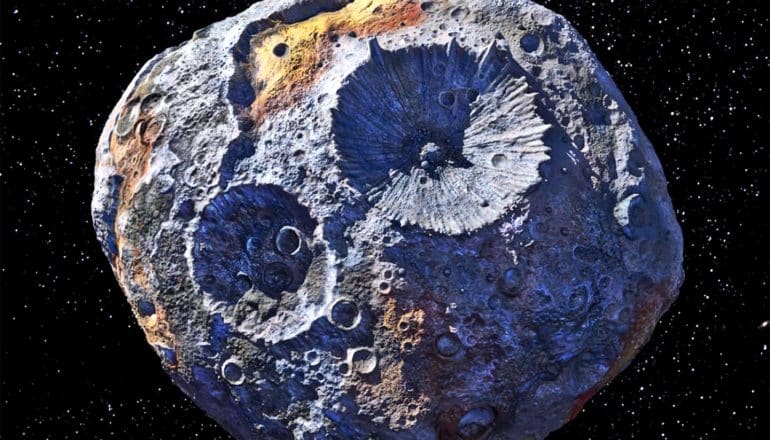
The widely studied metallic asteroid known as 16 Psyche might not be as metallic or dense as once thought, researchers report.
The asteroid was long thought to be the exposed iron core of a small planet that failed to form during the earliest days of the solar system.
The new hint at a much different origin story.
Scientists are interested in 16 Psyche because if its presumed origins are true, it would provide an opportunity to study an exposed planetary core up close. NASA is scheduled to launch its Psyche mission in 2022 and arrive at the asteroid in 2026.
As reported in in the Planetary Science Journal, researchers propose 16 Psyche is 82.5% metal, 7% low-iron pyroxene, and 10.5% carbonaceous chondrite that impacts from other asteroids likely delivered. The researchers estimate that 16 Psyche’s bulk density—also known as porosity, which refers to how much empty space is found within its body—is around 35%.
These estimates differ from past analyses of 16 Psyche’s composition that led researchers to estimate it could contain as much as 95% metal and be much denser.
“That drop in metallic content and bulk density is interesting because it shows that 16 Psyche is more modified than previously thought,” says lead author David Cantillo, an undergraduate student at the University of Arizona.
Asteroid 16 Psyche as a ‘rubble pile’
Rather than being an intact exposed core of an early planet, it might actually be closer to a rubble pile, similar to another thoroughly studied asteroid—Bennu. The University of Arizona leads the science mission team for NASA’s OSIRIS-REx mission, which retrieved a sample from Bennu’s surface that is now making its way back to Earth.
“Psyche as a rubble pile would be very unexpected, but our data continues to show low-density estimates despite its high metallic content,” Cantillo says.
Asteroid 16 Psyche is about the size of Massachusetts, and scientists estimate it contains about 1% of all asteroid belt material. First spotted by an Italian astronomer in 1852, it was the 16th asteroid ever discovered.
“Having a lower metallic content than once thought means that the asteroid could have been exposed to collisions with asteroids containing the more common carbonaceous chondrites, which deposited a surface layer that we are observing,” Cantillo says. This was also observed on asteroid Vesta by the NASA Dawn spacecraft.
Unexpected porosity
Asteroid 16 Psyche has been estimated to be worth $10,000 quadrillion (that’s $10,000 followed by 15 more zeroes), but the new findings could slightly devalue the iron-rich asteroid.
“This is the first paper to set some specific constraints on its surface content. Earlier estimates were a good start, but this refines those numbers a bit more,” Cantillo says.
The other well-studied asteroid, Bennu, contains a lot of carbonaceous chondrite material and has porosity of over 50%, which is a classic characteristic of a rubble pile.
Such high porosity is common for relatively small and low-mass objects such as Bennu—which is only as large as the Empire State Building—because a weak gravitational field prevents the object’s rocks and boulders from being packed together too tightly. But for an object the size of 16 Psyche to be so porous is unexpected.
“The opportunity to study an exposed core of a planetesimal is extremely rare, which is why they’re sending the spacecraft mission there,” Cantillo says, “but our work shows that 16 Psyche is a lot more interesting than expected.”
Next up: Water?
Past estimates of 16 Psyche’s composition were done by analyzing the sunlight reflected off its surface. The pattern of light matched that of other metallic objects.
Cantillo and his collaborators instead recreated 16 Psyche’s regolith—or loose rocky surface material—by mixing different materials in a lab and analyzing light patterns until they matched telescope observations of the asteroid.
There are only a few labs in the world practicing this technique, including the University of Arizona Lunar and Planetary Laboratory and the Johns Hopkins Applied Physics Laboratory in Maryland, where Cantillo worked while in high school.
The researchers believe the carbonaceous material on 16 Psyche’s surface is rich in water, so they will next work to merge data from ground-based telescopes and spacecraft missions to other asteroids to help determine the amount of water present.
Source: University of Arizona
The post Asteroid 16 Psyche may be less metallic than expected appeared first on Futurity.
from Futurity https://ift.tt/3iA27dK
No comments:
Post a Comment